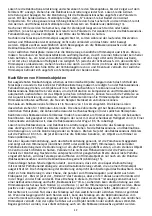
14
Operating the mount
The mount has controls for both conventional altitude (up-down) and azimuth (left-right) directions of
motion. These two adjustments are suggested for large direction changes and for terrestrial viewing.
To adjust azimuth, loosen the big knob under the mount base and rotate the mount head about the
azimuth axis. Use the altitude adjustment T-bolts to set the required altitude.
In addition, the equatorial mount has R.A. (hour angle) and Dec. controls for polar-aligned
astronomical observing. Loosen the lock knobs to make large direction changes. Use the slow-motion
controls for fine adjustment after the lock knobs have both been locked. An additional scale is included
for the altitude axis. This allows polar alignment at your local latitude (fig. 11).
Polar adjustment
In order for your telescope to track objects in the sky you have to align your mount. This means tilting
the head over so that it points to the North (or South) celestial pole. For people in the Northern
Hemisphere this is rather easy as the bright star Polaris is very near the North Celestial Pole. For casual
observing, rough polar alignment is adequate. Make sure your equatorial mount is leveled and the
finderscope is aligned with the telescope before beginning.
Look up your latitude on a map, road maps are good for this purpose. Now look at the side of your
mount head, there you will see a scale running from 0 to 90°. Loosen the mount latch slightly rotating
the lock handle counterclockwise. A thumbscrew located underneath the mount head pushes the latch
plate, thus changing the angle. Turn the screw until the pointer on the latitude scale is set at the
latitude of your observation site (fig. 12).
Loosen the Dec. lock knob and rotate the telescope tube until the pointer on the setting circle reads
90°. Retighten the Dec. lock knob. Loosen the azimuth lock knob and move the mount so that the
R.A. axis points roughly at Polaris. Use the two azimuth adjustment knobs above the “N” to make fine
adjustments in azimuth if needed. For more accurate alignment, look through the finderscope and
center the Polaris on the crosshairs using the azimuth and latitude adjustment knobs (fig. 13).
After a while you will notice your target drifting slowly North or South depending on the direction of
the pole relative to Polaris. To keep the target in the center of the view, turn only the R.A. slow-
motion control.
After your telescope is polar aligned, no further adjustments in the azimuth and latitude of the mount
should be made in the observing session, nor should you move the tripod. Only movements in R.A.
and DEC axis should be made in order to keep an object in the field. In the Southern Hemisphere you
must align the mount to the SCP by locating its position with star patterns, without the convenience
of a nearby bright star. The closest star is the faint 5.5-mag. Sigma Octantis which is about one degree
away. Two sets of pointers which help to locate the SCP are α and β Crucis (in the Southern Cross) and
a pointer running at a right angle to a line connecting α and β Centauri.
Tracking celestial objects
When observing through a telescope, astronomical objects appear to move slowly through the
telescope’s field of view. When the mount is correctly polar aligned, you only need to turn the R.A.
slow-motion control to follow or track objects as they move through the field. A R.A. motor drive can
be added to automatically track celestial objects by counteracting the rotation of Earth. If the object
is too faint you may want to use setting circles on an equatorial mount. Setting circles allow you to
locate celestial objects whose celestial coordinates have been determined from star charts.
The telescope’s R.A. setting circle is scaled in hours, from 1 to 24, with small lines in between
representing 10 minute increments. The upper set of numbers applies to observations in the Northern
Hemisphere, while the numbers below them apply to observations in the Southern Hemisphere.
Setting (calibrating) the R.A. setting circle: in order to set your Right Ascension circle you must first
find a star in your field of view with known coordinates. A good one would be the 0.0 magnitude star
Vega in the Constellation Lyra. From a star chart we know the R.A. coordinate of Vega is 18h 36m.
Loosen the R.A. and DEC. lock knobs on the mount and adjust the telescope so that Vega is centered
in the field of view of the eyepiece. Tighten the R.A. and DEC. lock knobs to lock the mount in place.
Now rotate the R.A. setting circle until it reads 18h36m. You are now ready to use the setting circles to
find objects in the sky (fig. 14).
A German Equatorial mount has an adjustment, sometimes called a wedge, which tilts the mount’s
polar axis so that it points at the appropriate Celestial Pole (NCP or SCP). Once the mount has been
polar aligned, it needs to be rotated around the polar axis only to keep an object centered. Do not
reposition the mount base or change the latitude setting. The mount has already been correctly
aligned for your geographical location (i.e. Latitude), and all remaining telescope pointing is done by
rotating the telescope tube around the polar (R.A.) and declination axes (fig. 15).
Содержание Skyline PLUS
Страница 2: ......


































